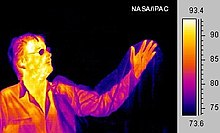
Back ارتياح حراري Arabic Confort higrotèrmic Catalan Tepelný komfort Czech Thermische Behaglichkeit German Confort higrotérmico Spanish آسایش گرمایی FA Confort thermique French נוחות אקלימית HE Kenyamanan termal ID 快適性評価 Japanese

Thermal comfort is the condition of mind that expresses subjective satisfaction with the thermal environment.[1] The human body can be viewed as a heat engine where food is the input energy. The human body will release excess heat into the environment, so the body can continue to operate. The heat transfer is proportional to temperature difference. In cold environments, the body loses more heat to the environment and in hot environments the body does not release enough heat. Both the hot and cold scenarios lead to discomfort.[2] Maintaining this standard of thermal comfort for occupants of buildings or other enclosures is one of the important goals of HVAC (heating, ventilation, and air conditioning) design engineers.
Thermal neutrality is maintained when the heat generated by human metabolism is allowed to dissipate, thus maintaining thermal equilibrium with the surroundings. The main factors that influence thermal neutrality are those that determine heat gain and loss, namely metabolic rate, clothing insulation, air temperature, mean radiant temperature, air speed and relative humidity. Psychological parameters, such as individual expectations, and physiological parameters also affect thermal neutrality.[3] Neutral temperature is the temperature that can lead to thermal neutrality and it may vary greatly between individuals and depending on factors such as activity level, clothing, and humidity. People are highly sensitive to even small differences in environmental temperature. At 24 °C, a difference of 0.38 °C can be detected between the temperature of two rooms.[4]
The Predicted Mean Vote (PMV) model stands among the most recognized thermal comfort models. It was developed using principles of heat balance and experimental data collected in a controlled climate chamber under steady state conditions.[5] The adaptive model, on the other hand, was developed based on hundreds of field studies with the idea that occupants dynamically interact with their environment. Occupants control their thermal environment by means of clothing, operable windows, fans, personal heaters, and sun shades.[3][6] The PMV model can be applied to air-conditioned buildings, while the adaptive model can be applied only to buildings where no mechanical systems have been installed.[1] There is no consensus about which comfort model should be applied for buildings that are partially air-conditioned spatially or temporally.
Thermal comfort calculations in accordance with the ANSI/ASHRAE Standard 55,[1] the ISO 7730 Standard[7] and the EN 16798-1 Standard[8] can be freely performed with either the CBE Thermal Comfort Tool for ASHRAE 55,[9] with the Python package pythermalcomfort[10] or with the R package comf.
- ^ a b c ANSI/ASHRAE Standard 55-2017, Thermal Environmental Conditions for Human Occupancy
- ^ Çengel, Yunus A.; Boles, Michael A. (2015). Thermodynamics: An Engineering Approach (8th ed.). New York, NY: McGraw-Hill Education. ISBN 978-0-07-339817-4.
- ^ a b de Dear, Richard; Brager, Gail (1998). "Developing an adaptive model of thermal comfort and preference". ASHRAE Transactions. 104 (1): 145–67.
- ^ Battistel, Laura; Vilardi, Andrea; Zampini, Massimiliano; Parin, Riccardo (2023). "An investigation on humans' sensitivity to environmental temperature". Scientific Reports. 13 (1): 21353. doi:10.1038/s41598-023-47880-5. ISSN 2045-2322. PMC 10695924. PMID 38049468.
- ^ Fanger, P Ole (1970). Thermal Comfort: Analysis and applications in environmental engineering. Danish Technical Press. ISBN 8757103410.[page needed]
- ^ Nicol, Fergus; Humphreys, Michael (2002). "Adaptive thermal comfort and sustainable thermal standards for buildings" (PDF). Energy and Buildings. 34 (6): 563–572. Bibcode:2002EneBu..34..563N. doi:10.1016/S0378-7788(02)00006-3. S2CID 17571584.[permanent dead link]
- ^ ISO, 2005. ISO 7730 - Ergonomics of the thermal environment — Analytical determination and interpretation of thermal comfort using calculation of the PMV and PPD indices and local thermal comfort criteria.
- ^ CEN, 2019. EN 16798-1 - Energy performance of buildings - Ventilation for buildings. Part 1: Indoor environmental input parameters for design and assessment of energy performance of buildings addressing indoor air quality, thermal environment, lighting and acoustics.
- ^ Tartarini, Federico; Schiavon, Stefano; Cheung, Toby; Hoyt, Tyler (2020). "CBE Thermal Comfort Tool: Online tool for thermal comfort calculations and visualizations". SoftwareX. 12: 100563. Bibcode:2020SoftX..1200563T. doi:10.1016/j.softx.2020.100563. S2CID 225631918.
- ^ Tartarini, Federico; Schiavon, Stefano (2020-07-01). "pythermalcomfort: A Python package for thermal comfort research". SoftwareX. 12: 100578. Bibcode:2020SoftX..1200578T. doi:10.1016/j.softx.2020.100578. ISSN 2352-7110. S2CID 225618628.